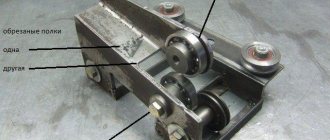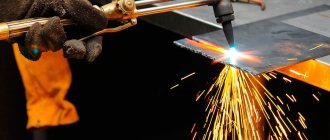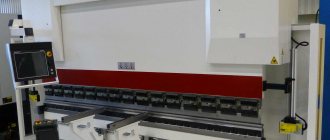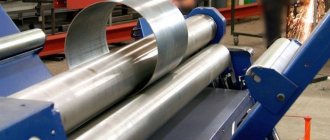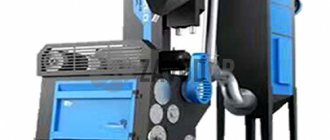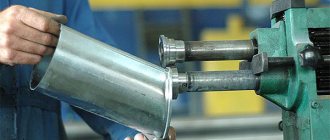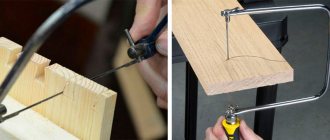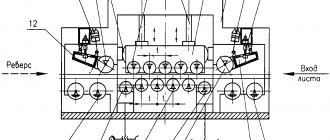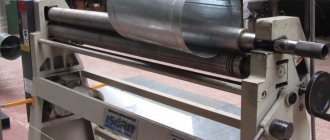10/23/2019 Author: VT-METALL
Issues discussed in the material:
- What is sheet metal cutting?
- What are the industrial types of sheet metal cutting?
- What tools can be used to cut sheet metal manually?
- What mechanical methods exist for cutting sheet metal?
- What is the principle of cutting sheet metal with a grinder and guillotine?
The quality of metal processing depends on many parameters: the technology used, the performance of the equipment, the skills of the craftsman, the characteristics of the raw materials, etc. Today in the article we will tell you that high-quality cutting of sheet metal is possible not only in production, but also at home, and We will also consider the main nuances of using the most popular equipment.
Industrial types of sheet metal cutting
Metal processing can be carried out in different ways. The specifics of the work depend on the type of equipment used for cutting metal sheets.
At large industrial enterprises, waterjet or thermal cutting is most often used.
1. Heat treatment of sheet metal.
Thermal cutting involves separating metal sheets with a jet heated to extreme temperatures. This type of cutting is also called non-contact cutting, since the tool does not interact with the surface of the sheet material.
Types of thermal cutting: oxygen gas, laser, plasma.
- Oxygen gas cutting of sheet metal.
Oxygen gas processing of sheet metal includes two stages:
- A jet of flame coming out of the cutter is supplied to the starting point of the intended cutting line. Acetylene is used as the working gas.
- After heating the material, the device supplies an oxygen flow, which easily cuts the softened metal. At the same time, oxides are removed.
In order for the cutting quality to be high, the distance between the cutter nozzle and the metal must be the same throughout the entire working process.
We recommend articles on metalworking
- Steel grades: classification and interpretation
- Aluminum grades and areas of their application
- Defects in metal products: causes and search methods
Oxygen cutting is the most economical cutting method and is excellent for cutting low alloy steels. If all the nuances of the technology are observed and the craftsman has sufficient experience, the edge of the sheet metal after oxy-fuel cutting does not require additional processing.
The disadvantage of using this type of cutting is that it can only process metals with low thermal conductivity.
- Plasma cutting of sheet metal.
Plasma cutting is considered a more universal method of processing sheet materials. The first equipment for this type of metal cutting appeared in the second half of the 20th century. The equipment was not only bulky, but also expensive, and therefore only large industrial enterprises could afford its acquisition and use. Over time, equipment has become more accessible, and the popularity of plasma cutting has grown exponentially.
In this case, metal processing is carried out using a high-speed plasma flow, the temperature of which can reach +30,000 °C. In this case, drops of molten metal formed as a result of melting are instantly blown away by a stream of compressed air. Compared to the previous type of cutting, plasma processing is highly productive, because the temperature of the oxygen gas flow is only +1,800 °C.
It is worth noting that the popularity of plasma cutting is explained not only by its high productivity, but also by a number of other important parameters. Thus, the work process does not require regular refilling of gas cylinders, additives for cutting valuable metals or increased attention to fire safety measures. To work with plasma equipment, you only need electricity and air, which allows you to draw objective conclusions about the simplicity, convenience and economy of the work process.
Plasma cutting of sheet metal can be used to process:
- aluminum and alloys based on it up to 120 mm thick;
- copper up to 80 mm thick;
- alloy and carbon steels up to 50 mm thick;
- cast iron up to 90 mm thick.
If the metal thickness exceeds 120 mm, it is more advisable to use oxy-fuel cutting.
When selecting the optimal equipment for metal processing, it is very important to take into account such properties as thickness and thermal conductivity. Here you need to remember one simple rule: the higher the thermal conductivity of the material being cut, the greater the heat removal and the smaller the possible thickness of the sheet being processed (for example, the thickness of a copper sheet should be less than a stainless steel sheet).
Metalworking services. Capabilities of our plant
Mechanical processing does not have any effect on the metal regarding its structure, technical characteristics and quality. Changes are made exclusively to the geometric shape of the workpiece, as well as its physical parameters (dimensions, weight). Customers can place orders that require standard or additional capacity and resources. Our plant employees carry out work in various ways:
- cutting a rough sample;
- deformation cutting of metal;
- plastic deformation (forging, stamping, pressing, thread rolling);
- electrical processing;
- electrophysical finishing (electroerosion, electrochemical, electric welding).
The most frequently performed type of work is mechanical cutting of rough material. The task is also performed using various methods. For example, by turning. This method is relevant in the case when the workpiece’s physical parameters practically coincide with the required result. Metal sandblasting, laser or plasma cutting are also performed. The method is selected depending on the nature of the selected material and the given sample.
Our production for processing metal products is equipped with modern equipment. Thanks to this, we can solve many problems of different nature. Here are some of them that are in great demand:
- carrying out turning works;
- broach;
- milling;
- boring;
- drilling;
- chiselling;
- planing;
- turning;
- grinding.
The process of cold working of metals or under the influence of high temperatures can consist of several stages. Each of them employs different machines and specialists. This is how we achieve maximum quality in the shortest possible time.
Tools for hand cutting sheet metal
Manual cutting of sheet metal cannot be called highly effective, so most often it is used only at home.
In the process of cutting sheet metal, the following tools are used:
- Scissors. Using hand scissors, you can process metal sheets whose thickness does not exceed 3 mm. There are several types of similar devices suitable for cutting metal:
- For straight cuts.
- For curvilinear.
- Finger (straight and mirror type) - used to obtain complex figures.
- With one movable blade, and the second fixed, fixed to the workbench.
- Hacksaw.
- Jigsaw.
- Bulgarian. This is an angle grinder used for cutting metal, which is operated manually. The main advantages of the grinder are:
- ease of use;
- the ability to process metal sheets of different thicknesses;
- Large selection of replacement disc options.
Thus, manual cutting of metal can be done using scissors, a special machine - an angle grinder or a pipe cutter.
The working elements of a pipe cutter are disc cutters-rollers, which provide convenience and proper speed for cutting cylindrical products.
The quality and speed of manual work largely depend on the experience and skills of the worker.
Devices for manual cutting have low productivity, therefore they are used for metal processing mainly in domestic conditions.
Processing of plastic sheet materials
Plastics are divided into two main types:
- Thermoplastics soften when heated and return to normal when cooled. They are used in the production of billboards, office partitions, construction and interior decoration.
- Thermosets - decompose when exposed to high temperatures. They are distinguished by increased strength and operating temperature, and can be processed by cutting. Sheet thermosets include plexiglass (acrylic), textolite and other polymers that are used in the production of electrical and utility equipment, and household appliances.
Mechanical types of sheet metal cutting
Mechanical cutting of metal is a contact processing method in which the surface of the tool interacts with the material. The cutting element, as a rule, is also made of metal, but of higher hardness.
The group of devices for mechanical cutting of sheet metal includes scissors, a saw and cutters. A special type of mechanical processing of metal sheets is cutting. Impact cutting or chopping with a guillotine is usually used at the stage of creating workpieces.
Sheet metal machining can also be performed using the following equipment:
- band saw machines (LPS);
- guillotine;
- disk machines;
- lathes with cutters installed on them;
- slitting units.
1. Cutting with a band saw.
It is advisable to use a band saw for processing long metal. This device is the main working element on a band saw machine (LSS). The operating principle of the saw is similar to that of a conventional hacksaw. The saw blade is enclosed in a large diameter band, one side of which has special teeth. Continuous movement of the belt is ensured by rotating pulleys connected to an electric motor. The average operating speed of the LPS is 100 mm/min. The working blade for such machines is usually made of carbon steel or a bimetallic alloy.
The advantages of using LPS include: accuracy, availability, favorable cost of equipment, the ability to perform both straight and angular cuts, efficiency (minimum amount of waste).
Modern machines for cutting sheet metal are equipped with electronics and additional elements, which allows them to be included in the production line if necessary.
Various stripping methods
Below are the most popular methods for stripping sheet metal products:
Hand sanding: One of the oldest and most popular processes for removing surface defects. With this method, surface imperfections are removed manually using a special tool. It is consistently popular due to its cost-effectiveness, but is not recommended for large parts.
Electrochemical stripping: the defective part of the sheet is immersed in a solution of glycol or salt and exposed to electric current. This cleaning is ideal for small parts that may have burrs in hard-to-reach areas.
Thermal energy cleaning: one of the most frequently discussed methods for removing surface defects. With it, a metal part or sheet is placed in a sealed chamber and the burrs are removed through the reaction of a fuel. This method of removing defects is suitable if it is necessary to process several parts or surfaces at the same time.
Vibration Cleaning: If you work with soft metal products, many of the above surface cleaning methods may not be suitable for you. Here it may be worth choosing vibration treatment. The defective part is placed in a rotating drum along with various abrasive components or liquid. The abrasive is rubbed into the product being cleaned as the drum rotates at high speed. Popular abrasives include plastic, ceramic, steel particles and granules. This method is ideal for removing surface stains and sharp edges.
Water jet cleaning removes defects from the surface using water and ensures a clean surface.
Surface cleaning is one of the major considerations in the sheet metal industry. It is very important to use the most suitable tool to achieve the required surface quality and smooth, burr-free edges. Such a tool is purchased from a reliable supplier that provides both cleaning equipment and consumables and tools for surface treatment.
Basic process and safety precautions when cutting sheet metal with an angle grinder
Compliance with safety regulations is the most important point, neglect of which can result in injuries of varying severity.
Here are a few rules that should be followed when cutting sheet metal with a grinder.
- Disk size . It is a mistake to believe that its size can be selected without taking into account the size of the angle grinder. Do not install a large blade without a protective cover on a small tool, otherwise you may put your life in danger. The speed of a small grinder is much higher, so they need appropriate cutting elements. Having installed a large disk, you won’t even have time to draw a cutting line; the toothed circle will simply fly apart after turning it on.
- Direction of rotation . Some workers are not satisfied with the direction of sparks that are observed during standard operation of the tool. So they unroll the casing, rearrange the handle, and start cutting. Arbitrariness in this matter can lead to the fact that when caught on a sharp edge, the cutting disk will fly apart into pieces. Remember - the rotation of the disk should be done “towards you”, and not vice versa.
- Personal protective equipment . The presence of such devices is a prerequisite for working with an angle grinder. Safety glasses, gloves and a respirator will help avoid injury to vital organs.
1. Normal cutting of thin sheet metal.
Cutting metal of small thickness usually does not cause any particular difficulties. The key to a high-quality result in this case is attentiveness and accuracy. It is worth noting that when processing thin metal sheets, the cutting disc often “bites.” Before starting work, you need to make sure that there are no defects on the cutting surface of the circle. Their presence can lead to splitting of the toothed disc.
The cutting line should start from the far edge of the sheet (it turns out that the master is, as it were, pulling the grinder towards himself). The cutting disc should not be immersed too deeply into the material (maximum 5-6 mm). The correct direction of movement of the tool and a shallow immersion depth will help to avoid the disc getting caught. And vice versa - excessive immersion of the cutting element will lead to a decrease in the contact area, snags and subsequent splitting of the disc.
2. Cutting thick sheets of metal with a grinder.
If the thickness of the sheet metal is more than 8 mm, then you should move the tool away from you rather than towards you. However, if you simply cut along the drawn line, you will not get a perfectly straight edge. In addition, you can overexert your hand, because you will have to constantly control the movement of the grinder.
To facilitate the work process, installing a steel angle at the cut site, which is pressed against the sheet with clamps on both sides, will help. Now you can walk along the drawn line several times, touching the corner a little so that you get a small indentation (no more than 1-2 mm). After the recess is made, you can remove the corner and proceed directly to metal processing. This way the cutting disc will not leave the intended line, and the edge will be perfectly straight.
3. Another cutting option.
The first stages of the work completely coincide with the method described above: a line is drawn, a corner is laid and pressed. The peculiarity is that the recess in this case is made a little deeper - about 4-5 mm. After removing the corner, the remaining metal can simply be broken off, and the edge can be processed using an angle grinder with a grinding disc. It is worth noting that such processing does not guarantee a high-quality result, so the second method is used much more often.
The grinder allows you to quickly and efficiently process sheet metal, but successful use of this tool is possible only if you have sufficient skills and comply with all safety regulations.
The nuances of cutting sheet metal with a guillotine
Guillotines are used for cutting sheet metal at home or in small factories.
1. What can be cut with a guillotine?
Using a guillotine, you can process metal no worse than using factory equipment. Moreover, craftsmen often make guillotine shears at home.
The most common versions of guillotines are models with a direct movement of the knife and with a change in angle. In the first, the knife moves in a vertical position and allows you to cut sheet metal evenly. The use of models of the second group allows not only cutting sheet metal, but also processing reinforcement bars and large metal angles.
The working capabilities of homemade guillotines are usually limited. This is because, unlike industrial designs, which have different types of drive (hydraulic, pneumatic or electric), a homemade device for cutting sheet metal is usually equipped only with a mechanical lever or pedal mechanism. The depth of cut when using homemade installations depends on the amount of force applied by the master.
Using homemade guillotines you can cut:
- sheets of black and galvanized steel up to 1.5 mm thick;
- stainless steel sheets up to 0.6 mm;
- aluminum;
- plastic;
- cardboard.
When making guillotine shears, you should definitely take into account the type of metal that you plan to process.
2. Operating principle.
Metal cutting using guillotines can be carried out both longitudinally and transversely. Installation options depend on the type of knives installed and their location. When making a cross cut, the knife makes one movement. Longitudinal cutting is accompanied by several movements that will be repeated together with the translational movements of the product. Longitudinal cutting is performed when processing rolls or when it is necessary to cut sheets longer than 2 m.
The guillotine works on the following principle: a sharp knife, under its own weight, is lowered onto a metal surface at high speed. Sometimes the cutting speed or weight of the knife is not enough to cut a certain type of metal or the required thickness. Therefore, the design of the machine is often equipped with an additional element - a lower fixed knife. This setup works like a regular guillotine and scissors.
The presence of an auxiliary element, of course, leads to an increase in the final cost of the equipment, but at the same time it allows you to improve the quality and increase the processing speed of metal parts.
Important rules, nuances and features of sheet processing (sheet processing)
Good afternoon, dear friends, gardeners and gardeners! I welcome you to our “Country Stories” community.
Foliar treatment, or leaf spraying, is used quite often. By treating the leaves with fungicides, you can prevent fungal diseases or use it to treat plants. Spraying with insecticides can destroy pests if they have attacked plants.
The addition of microelements on the leaf quickly saturates the plants with the necessary substances. Hormonal drugs direct the growth and development of the plant in the right direction, and anti-stress drugs help to wait out difficult weather conditions. As you can see, foliar processing performs many tasks, but let’s figure out how effectively it copes with them.
https://vk.com/photo-159774511_457247931
Batteries.
Let's start with nutrition. As a rule, we introduce microelements in the form of leaf treatments. This is justified, because Plants have small needs for microelements, and the dose received is quite enough to compensate for the lack of some element.
Iron, copper, zinc.
Elements such as iron, copper, zinc are ideally applied over the sheet. The requirements for these substances are small, and such treatment gives quick results. For foliar treatments, chelated forms of metals should be used. They are well absorbed by plants. Ordinary copper or iron sulfate is practically not absorbed through the leaf, unless they are converted into chelate form.
Bor.
Even an element such as boron is absorbed differently. There is no chelated form of boron, but scientists have developed formulations with organic compounds that improve boron absorption and make it safe.
There are various preparations for treating leaves with boron, for example, “Boromine gel”. Boric acid is best used for root feeding, because In this form, boron is toxic to leaves and causes burns.
Calcium.
Calcium, which is often applied leaf by leaf to prevent the development of blossom end rot, is also absorbed differently. The most common fertilizer with calcium, calcium nitrate, should not be applied leaf by leaf. Nitrate nitrogen, which is included in its composition, is poorly absorbed through the leaves and even causes burns. Therefore, we use calcium nitrate to feed the roots, and apply chelated calcium along the leaves.
Phosphorus.
Sometimes macroelements are added one leaf at a time. For example, if cold weather sets in after planting seedlings, the phosphorus necessary for root formation is not absorbed from the soil. Treatment of leaves with potassium monophosphate allows plants to receive some phosphorus and begin to grow. By activating nutrition through leaves and roots, they will engage in more active work.
But it is important to understand that when processed per leaf, plants receive only 20% of their daily requirement for basic substances. This applies not only to nitrogen, phosphorus and potassium, but also to microelements, the needs of which are significant: calcium, magnesium, sulfur. So it won’t be possible to abandon root dressings and replace them with leaf-based processing. So we would have to spray the plants daily.
How often should I treat?
Sheet treatments are usually carried out once a week. If necessary, you can do this a little more often, maximum once every 4 days. You should not spray plants with different preparations every day. This will only harm them, since the leaves will always be damp.
At what time should the treatment be carried out?
Excessive moisture is a feature of foliar treatments. This factor must be taken into account when choosing processing time. If for open ground plants additional moisture is not critical; in the open air it will quickly disappear, then for greenhouses you need to choose the time individually.
In the evening.
It is generally accepted that it is better to carry out processing in the evening, early morning or in cloudy weather. This is based on the fact that droplets on the leaves turn into lenses when exposed to sunlight. Just as you can light a fire through a magnifying glass, so too through dozens of drops plants can get burns on their leaves. This is very important for open ground.
In the morning.
But in greenhouses there is such a factor as humidity. In rainy, cloudy weather, the humidity in the greenhouse will already increase; there is no need to increase it further by treating the leaves. At night, due to temperature changes, the humidity in greenhouses increases and condensation forms. This provokes the spread of fungal diseases. In order not to increase the risks, it is better not to spray plants in greenhouses in the evening, but to do it early in the morning.
In the morning it is good to create additional humidity, because on a hot day greenhouses overheat in the sun. Too dry and hot air is not the best conditions for pollination. At low humidity, flowers may fall off without forming an ovary. Spraying in the morning will increase the humidity slightly.
Tank mixtures
In order to reduce the number of treatments, it is good to use tank mixtures. In one tank you can combine fungicide, insecticide and microelements. This is much more convenient than carrying out three different sprays. But it is important to understand that not all substances can be combined in one tank.
In any case, if you are not sure about the compatibility of the drugs, it is better to first dilute a small amount for testing. If any substance precipitates, the drugs are not compatible. If everything is in order, then processing can be carried out.
When using some new product or mixture of several drugs, you can play it safe and treat one plant first. If it feels good a couple of days after treatment, you can spray all the other plants.
"Chemistry"
Chemicals have a complex formula. When combining two drugs, an unexpected effect may occur in the form of the formation of unknown substances. The consequences of such processing cannot be predicted. Therefore, “chemistry” should be mixed only with those drugs that are indicated in the instructions.
"Chemistry" and bacteria
“Chemistry” and biological products should not be combined at all, because chemical fungicides or pesticides are very aggressive and will destroy not only the pathogenic microflora, but also the beneficial ones that we pour into the tank. But biological products combine well with each other, with a few exceptions.
Activators and Adhesives
Well, and, of course, do not neglect adding adhesive to the solution for foliar treatment. This allows the solution to better adhere to the leaves, and the effectiveness of the treatment increases. As an adhesive, you can use laundry soap or various available substances, such as gelatin, starch, glycerin, etc. There are many ready-made adhesives on the market.
Different adhesives can be used for different treatments. When using biological products with live bacteria, you should not add alkali (laundry soap) or surfactants (washing powder, liquid soap and some types of ready-made adhesives). These substances act aggressively and kill most bacteria. For biological products, it is better to use the organic adhesive “Liposam” or glycerin, gelatin, starch.
Adding a small amount of humic preparations to the solution improves the absorption of the solution and its penetration into plant tissue. With this additive, any substances are delivered faster, which means the processing efficiency increases.
https://vk.com/photo-159774511_457247932
Thank you for your interest in my article.
What determines the price of custom sheet metal cutting?
The cost of cutting sheet metal is determined by a combination of interrelated factors, such as:
- technology used;
- equipment power;
- brand, thickness of raw materials;
- quality of finished products;
- order quantity.
If during the work a large amount of raw materials will be used, the cost of the order can be reduced by reducing the value of the price of the accounting unit (kilogram, linear meter).
The cost of producing small batches is discussed with the customer individually in each specific case. The price of cutting sheet materials is not always calculated using the formula “unit cost multiplied by quantity”, since any order requires reconfiguration of working equipment.
Today, manufacturers use a variety of technologies for cutting sheet metal, but the main criteria for the customer are still the quality of work, production time, cost, and the availability of additional transportation services.

